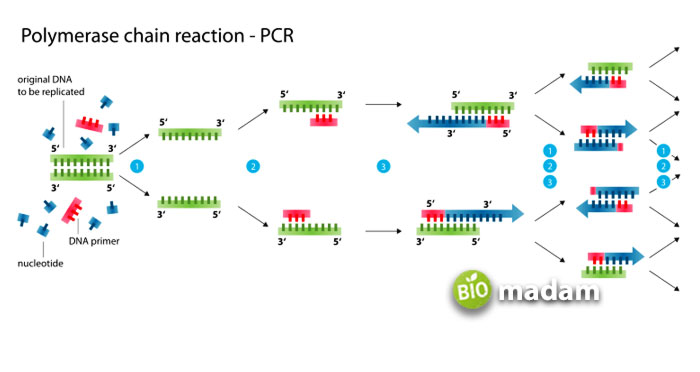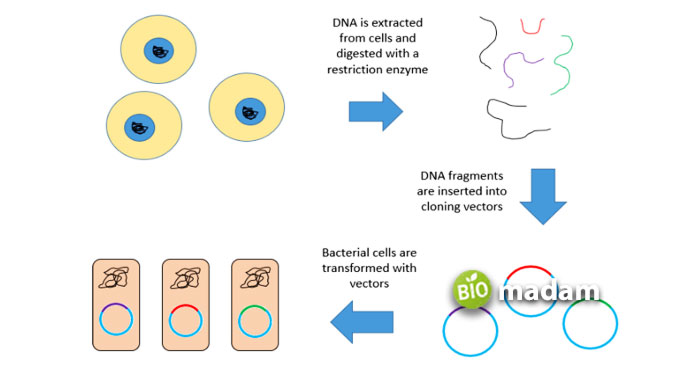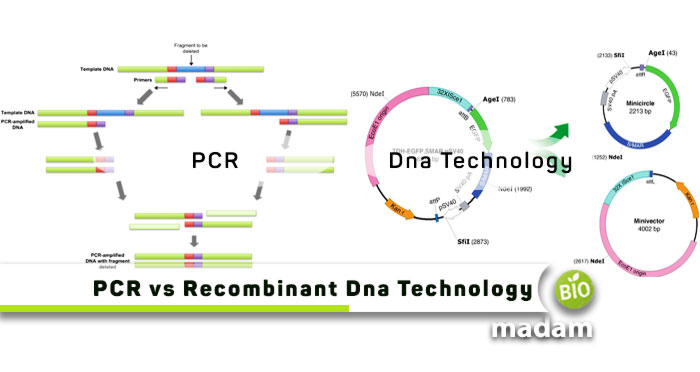There are numerous vaccines discovered to date that have served the purpose of saving lives. Similarly, you might have seen human insulin and similar medications to treat patients – all of these are the efforts of biotechnology! This field constitutes many processes where DNA amplification is the major and further involves PCR and recombinant DNA technology.
Both of these technologies start with a common process, but PCR is aimed at generating thousands to millions of copies of a gene of interest. Other key differences between PCR and recombinant DNA technology include the former taking place in vivo inside a host bacterium. In contrast, the latter is being produced in vitro through repeated cycles. As these processes have proved to be helpful, scientists are utilizing them in various biological applications till now. Let’s step ahead to understand in detail what is PCR and recombinant DNA technology and how they differ.
Comparison Table
| Features | PCR | Recombinant DNA |
| Process Type | In vivo | In vitro |
| Purpose | Amplify DNA fragments | Manipulate genes |
| Enzymes | DNA polymerase | Restrictive enzymes |
| Primer Requirement | Yes | No |
| Product | Copies of DNA region | Recombinant DNA molecules |
| Template | DNA or RNA | Plasmids, vectors, DNA |
| Target Region Size | Short fragments | Large DNA segments |
| Temperature | Thermal cycling | Variable temperature |
| Main Objective | Copy specific DNA | Create new DNA constructs |
What is PCR?
Polymerase chain reaction, or PCR, was initially introduced by the American biochemist “Kary Mullis” in 1983. After almost a decade, he was given a noble prize for developing such a fruitful process. Typically speaking, PCR is a widely known biotechnological process that makes millions and billions of copies of a desired gene through amplification. This technique is simple yet very useful in the field of molecular biology that utilizes DNA polymerase and some laboratory steps to continue. We must say scientists are able to get bulk genetic information with just a tiny fragment of its information, thus making huge discoveries.
A single PCR involves three significant steps that are repeatedly processed to generate what biologists or scientists desire. Before we comprehend what are the steps of PCR, let’s briefly look at the components required to kick-start it:
- DNA or RNA specimen of interest that needs to amplify
- A short piece of single-stranded DNA, called DNA primer, encourages the production of a complementary strand of nucleotides
- Taq DNA polymerase to aid in creating complementary strands
- A mixture of the nucleotides, i.e., adenine (A), thymidine (T), cytosine (C), and guanine (G)
Steps of PCR
There are several types of PCR techniques, but no matter what the type is, its underlying principle and the steps will remain the same that processes on the thermal cycler. These are:
- Denaturation: The first step involves heating sample material from 94 – 98°C. It denatures the double-stranded DNA and divides it into two single strands.
- Annealing: The second step involves lowering the temperature to between 55 and 72°C so the primers can anneal or attach to specific DNA sequences at each end of the target sequence, commonly known as the template.
- Extension: The temperature is often raised to 72°C in the third step, enabling the DNA polymerase to extend the primers by adding dNTPs to generate a new strand of DNA. This generation of new strands ultimately results in doubling the amount of DNA in the reaction.
The process is then automatically repeated 35 to 40 times using a thermal cycler, which recounts the heating and cooling cycles. The resulting DNA sequence is doubled with each heating/cooling cycle the cycler does. Therefore, you can amplify a tiny piece of DNA from one sample to create millions of copies after 35 doubling cycles.

Applications of PCR
This revolutionary technology has a wide range of scientific applications in almost all fields of biology. Some of the applications that are making revolutions for humanity are below:
- The DNA amplification of specific gene segments makes it possible to study them in detail, thus promoting genotyping, DNA cloning, and DNA sequencing.
- PCR is used to generate DNA fragments with specific sequences, which can be easily cloned into vectors for applications such as gene expression studies, the formation of vaccines, and protein production.
- Different types of PCR, such as reverse transcription PCR, help quantify gene expressions, resulting in details of gene regulation and its functions.
- Besides, mutagenesis and DNA methylation analysis are other benefits grasped by PCR. This polymerase chain reaction-based methylation is useful for investigating DNA patterns.
- You can also use PCR in microbial ecology, environmental sciences, and microbiology, especially when finding microorganisms in the environment is necessary.
- Moreover, PCR is a widely known technique to help detect and analyze trace amounts of DNA in forensic labs, thus helping to solve critical crime cases.
- Pharmaceutical research labs utilize it to replicate and analyze DNA and RNA samples for use in the production of antibiotics and vaccines.
- Many Food and Agriculture Biotechnology researchers are using PCR to meet the demands of a growing population.
What is Recombinant DNA Technology?
Recombinant DNA technology, also known as DNA cloning, is a method involving the separation of gene segments from the DNA of a larger chromosome and attaching it to the small molecules of carrier DNA. When formed, this new molecule (or modified DNA) replicates either by increasing the cell membrane structure or creating multiple DNA copies. In other words, this technology helps scientists cut and recombine two different DNA segments to create a new combination of genetic material. Methods that are used to accomplish this process are called genetic engineering.
The first experimented plasmid to create a recombinant DNA was isolated from Escherichia coli. Even now, this bacterial species is the most common and preferred host to be utilized in the rDNA process:
- This organism is relatively simple, so it’s easy to understand the metabolism and biochemical process.
- E. coli is inexpensive, and its clone vectors, e.g., plasmids, are well-characterized.
- Our science laboratories have a large number of E. coli-compatible molecular tools available, so it’s easy to continue generating recombinant strands of DNA.
Steps of Recombinant DNA Technology
The most common steps in recombinant DNA technology are:
- Isolation of DNA (Genetic Material): The very first step is to isolate or extract the DNA of interest from a source organism. The cell must split open to release DNA and other macromolecules, including RNA, proteins, carbs, and lipids because the membrane shields the DNA.
- DNA Cutting: Restriction enzymes are used for this purpose, which allows the necessary DNA fragments to be produced by cutting DNA at specific recognition sequences. These enzymes create “sticky ends” with overhanging sequences that can base-pair with complementary ends and are monitored using agarose gel electrophoresis.
- Isolation of Vector DNA: A vector in rDNA technology is usually a plasmid that is isolated and cut with exactly the same restriction enzyme as used before. It is a valuable step as it results in compatible joining of the sticky ends.
- Ligation and Transformation: The joining of the DNA of interest and the vector is proceeded through ligation, with the help of ligase enzyme. This results in a recombinant DNA molecule where the desired gene is already inserted. Then, this rDNA meets the host organism through bacterial transformation, where the host cell takes charge of replicating the recombinant DNA.
- Culturing and Expression: As the desired protein is the primary goal of the entire procedure, these segments are cultured inside the host cell. One must keep the ideal conditions for inducing the expression of the target protein after the gene of interest has been cloned, and one should think about mass manufacturing it. A “recombinant protein” has a gene for a protein produced in a heterologous host. Any techniques, including insertional inactivation, blue-white screening, nucleic acid hybridization, and immunological approach, can be used to select and screen altered cells.

Applications of Recombinant DNA Technology
This advanced isolation process has helped the field of science, from research to biotechnology to producing new medicines. The way scientists manipulate DNA fragments and produce useful components, like vaccines, is a big success! Let’s go through some of the applications of recombinant DNA technology:
- Scientists often use this technique to create essential medicines like insulin and vaccines.
- rDNA has dramatically helped in DNA and PCR tests to detect diseases, especially the very pandemic – coronavirus.
- This technology is widely utilized in agriculture to optimize crop yield. Agriculturalists have made ways to create particular crops that do not allow pests to invade and destroy the food. It ultimately means we have more room to grow food and waste less.
- Besides, recombinant DNA helps in gene therapy by inserting modified genes in a patient suffering from genetic diseases or disorders.
- Scientists use this technology to study and make substances like biofuels and enzymes that are further employed in industries.
PCR vs Recombinant DNA Technology – Key Differences
Mechanism
PCR
In PCR, there is usually no host organism involved, and the process is carried out in vitro through small DNA fragments. There is no need for external living organisms.
Recombinant DNA Technology
On the other hand, recombinant DNA technology needs a host organism to replicate, such as bacteria or yeast. Here, the DNA fragments are expressed and replicated from several sources using the suitable vector.
Primary Purpose
PCR
The primary purpose of this PCR technique is an amplification of DNA sequences to make billions of copies. It initiates replication of target DNA fragments to help in genetic sequencing.
Recombinant DNA Technology
In contrast, rDNA technology combines fragments of two different DNA from different sources to make a new organism that is for a specified purpose. This technology is central to genetic engineering and the creation of genetically modified organisms.
Enzymes
PCR
PCR uses DNA polymerase as a crucial enzyme for creating complementary strands.
Recombinant DNA Technology
Whereas the process of the rDNA utilizes restrictive enzymes to isolate and cut the fragments of DNA.
Steps
PCR
PCR involves three main steps that take place at different temperature ranges. These are denaturation, annealing of the primers, and DNA extension.
Recombinant DNA Technology
Conversely, in recombinant DNA technology, the significant steps are genetic material isolation, DNA cutting, isolation of vector DNA, ligation, transformation, culturing, and expression.
End Result
PCR
The end result of a PCR reaction is the amplification of a specific DNA sequence. It provides a larger quantity of the target DNA for further applications, such as forensic testing.
Recombinant DNA Technology
On the contrary, recombinant DNA technology results in the creation of recombinant DNA molecules. These can be used for a wide range of applications, from genetic modification to protein production.
Applications
PCR
As already discussed, PCR is actively involved in a variety of applications, such as mutagenesis, methylation, cloning, DNA sequencing, etc.
Recombinant DNA Technology
At the same time, recombinant DNA technology is employed in the pharmaceutical industry to produce insulin and is actively helping the agricultural industry control pests. Moreover, nowadays, scientists are using gene therapy to treat genetic disorders.
Limitations
PCR
Besides being very helpful, PCR still has a number of limitations. It requires prior knowledge of at least a single part of the sequence of target DNA. Moreover, Taq polymerase used in the process is limited to proofreading the genetic information, thus resulting in incorrect or non-significant nucleotides.
Recombinant DNA Technology
Just like PCR, rDNA technology is also limited to an extent. Many people believe that this scientific invention is against the laws of ethics and nature. It has destroyed native species as the species are genetically modified. Moreover, gene therapies can lead to cross-contamination or serious diseases in the DNA of organisms.
The Bottom Line
There are numerous differences between PCR and recombinant DNA technology, but both play a significant role in genetic engineering. They help researchers study, isolate, and modify DNA to alter an organism’s genotype and phenotype. Polymerase chain reaction is just a single technique of rDNA used to amplify particular DNA fragments. However, recombinant DNA technology widely helps in creating new DNA combinations to give scientists the desired product.
FAQs
What is one similarity between PCR and recombinant DNA technology?
PCR and recombinant DNA technology are DNA synthesis processes. They take place in 5′ to 3′ direction in each strand to separate them from each other and multiply DNA.
What is one major difference between PCR and DNA replication?
DNA replication occurs naturally in living organisms, whereas PCR is conducted in laboratories to create genes artificially. Thus, we can produce genes and DNA of choice through PCR.
What is the difference between PCR and gene cloning?
PCR takes place in vitro without the need for a host organism. On the other hand, gene cloning is an in vivo process that requires a host organism to produce duplicate genes through recombinant DNA.
What natural process is PCR based on?
PCR is based on DNA replication, where the DNA polymerase synthesizes new strands of DNA complementary to the other DNA strand.

Jeannie has achieved her Master’s degree in science and technology and is further pursuing a Ph.D. She desires to provide you the validated knowledge about science, technology, and the environment through writing articles.

